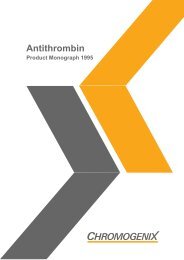Plasminogen - Chromogenix
Plasminogen - Chromogenix
Plasminogen - Chromogenix
Create successful ePaper yourself
Turn your PDF publications into a flip-book with our unique Google optimized e-Paper software.
The fibrinolytic system<br />
Evolution of fibrinolytic enzymes<br />
<strong>Plasminogen</strong> and its natural activators (t-PA, u-PA)<br />
belong to a large family of enzymes considered to<br />
have evolved from an ancestral protease similar to<br />
trypsin- a serine protease of broad specificity that<br />
breaks down dietary proteins. The kinship between<br />
the fibrinolytic enzymes in question and trypsin is<br />
attributed to their similar protease moiety, which<br />
cleaves proteins on the C-terminal side of arginyl<br />
and lysyl residues. Stretches of high homology are<br />
generally found in the active site pocket composed<br />
of serine, histidine and aspartic acid.<br />
During evolution, several types of homologous<br />
units or domain structures (generally coded by<br />
individual exons) have been added to the trypsin-like<br />
protease, enabling the fibrinolytic proteases to<br />
gradually fulfill more specialized tasks. The addition<br />
of five kringle domains gave rise to plasminogen,<br />
whereas the addition of two kringles, one finger and<br />
one EGF (epidermal growth factor) domain gave rise<br />
t-PA. In similar fashion, the addition of one kringle<br />
and EGF domain gave rise to u-PA (Figures 2–3).<br />
<strong>Plasminogen</strong><br />
Human plasminogen is a single-chain glycoprotein<br />
containing 791 amino acid residues and 2% carbohydrate.<br />
Its molecular mass is about 92,000 daltons.<br />
The plasminogen molecule contains a total of six<br />
structural domains, each with different properties. 8-10<br />
The N-terminal portion of the molecule consists of<br />
five kringle domains with the capacity to bind to<br />
fibrin. The kringle domain was first described by<br />
Magnussen et al (1975) who compared the structure<br />
with Danish pastry. Together with the preactivation<br />
peptide, the kringles control the ability of plasminogen<br />
to adopt different conformations. The protease<br />
domain resembles that of other serine proteases and<br />
contains the active site pocket His603 , Asp646 and<br />
Ser741 . This region also contains Ala601 which appears<br />
to be essential for the normal function of plasminogen,<br />
since mutation to Thr601 leads to an increased<br />
risk of thrombosis. 10<br />
<strong>Plasminogen</strong>, version 1.1<br />
Biochemistry<br />
5<br />
<strong>Plasminogen</strong> facts<br />
Name: <strong>Plasminogen</strong><br />
Synonym: Profibrionolysin<br />
History: The existence of plg.<br />
postulated by Dastre in 1938,<br />
identified by Christensen in 1945<br />
purified by Kline 1953<br />
Biosynthesis: Liver<br />
Concentration: 200 μg/ml<br />
Half-life: 2.2 days (Glu-plg.)<br />
0.8 days (Lys-plg.)<br />
Molecular weight: 92.000 daltons<br />
Carbohydrate: 2%<br />
Primary structure: 791 amino acids<br />
Function: Inactive precursor of plasmin<br />
Type: Serine protease<br />
Gene: Located on chromosome<br />
6, position q26-q27, length 53.5 kb<br />
containing 19 exons<br />
Importance: Hereditary defects of plasminogen<br />
is a predisposing risk factor for<br />
thromboembolic disease<br />
Several forms of plasminogen in plasma are<br />
known and can be separated by affinity chromatography.<br />
11 The native form of plasminogen in plasma<br />
has glutamic acid at the N-terminal and is termed<br />
Glu-plasminogen. Other plasminogen forms generated<br />
by the catalytic cleavage by plasmin and containing<br />
mostly lysine at the N-terminal position, are<br />
termed Lys-plasminogen.<br />
Glu-plasminogen exists in a closed conformation<br />
that becomes extended when binding to lysine<br />
residues on a fibrin surface. A similar conformational<br />
change is believed to take place when Glu-plasminogen<br />
is converted to Lys-plasminogen. The<br />
physiological role of these conformational changes<br />
is not well known although the general effect is<br />
believed to be an increased plasminogen activation<br />
rate catalyzed by t-PA. 12,13 The opposite effect is<br />
observed in the presence of anions, in particular with<br />
Cl - , which stabilizes the closed form of Glu-plasminogen<br />
rendering plasminogen poorly activatable. 14



